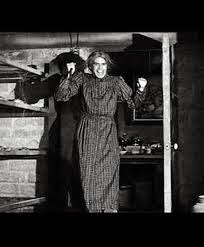In the aforesaid essay I questioned in part whether or not Sherlock Holmes was always a naturalistic figure in all of his iterations. In the third essay in this series, I observed an opposing tendency in the villain of the Holmes film A STUDY IN TERROR:
I have yet to encounter a fictionalized Jack the Ripper, however, whose spectre does not suggest either "the uncanny" or "the marvelous." This is in contrast to many other perilous psychos.The character in STUDY is of the "uncanny" type, which means that he does not violate the regularity aspect of causality, but does transgress upon the expectations of intelligibility. Jack the Ripper in STUDY IN TERROR is uncanny because he is "anti-intelligible," because he cannot be reduced to naturalistic causes, even though his real-life model probably was no more than a crazy man.
A STUDY IN TERROR is also a combative film in that its hero and villain engage in a battle of spectacular violence near the film's climax. Because this Ripper is no more than an ordinary man possessed of uncanny madness, he is also "megadynamic" in the sense I used the term here.
It may be harder, though, to see all such uncanny figures as megadynamic, since not all of them are as combative. In the 1960 PSYCHO, Norman Bates is a megadynamic figure only while he pretends to be his crazed, axe-murdering mother, and only when he is assaulting women in a relatively helpless position. When this psycho is caught by an ordinary husky man, Norman's appearance of power is stripped from him like his phony white-haired wig.
I suppose that I could solve the dilemma the same way I solved the fluctuation of power-levels in the three dynamicities in DYNAMIC DUOS PT. 2: Norman is merely an "exemplary" psycho, while Jack the Ripper is an "exceptional" one. But I find it worth noting that Norman, both in his initial prose and film incarnations, is superior in terms of his mythicity to the Ripper-character from STUDY IN TERROR. This suggests that he is a better conduit for the "combinatory-sublime," even as the Ripper is a better conduit for "the dynamic-sublime."
At present I have not found a necessary connection between the two forms of the sublime. It does suggest to me how some figures of comparatively low dynamicity can suggest that they are more powerful than they really are. I conclude that it is because of the effect of the combinatory-sublime, which seems to invest such figures with a larger-than-life "mana."


No comments:
Post a Comment